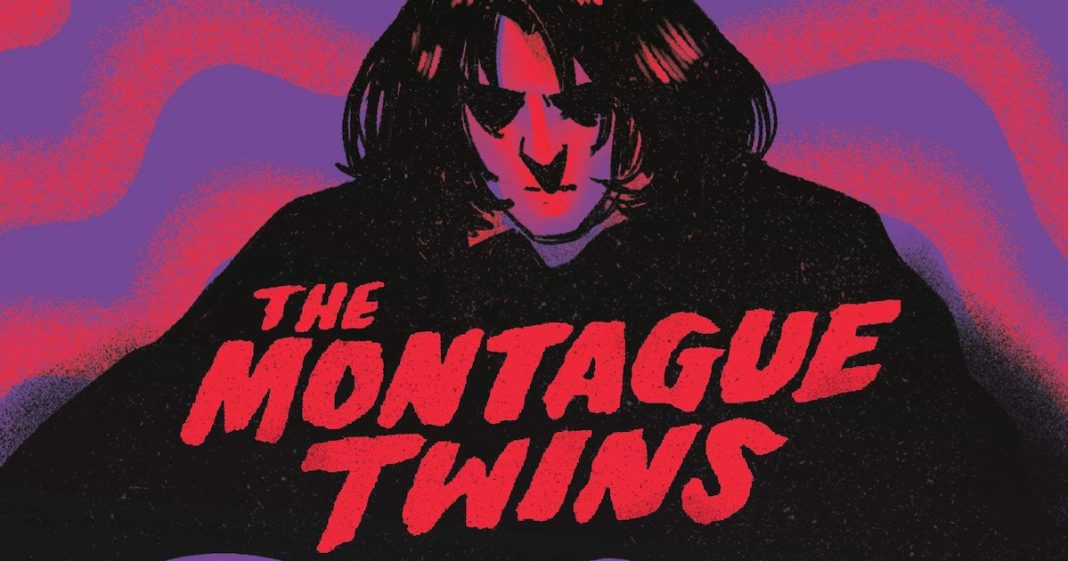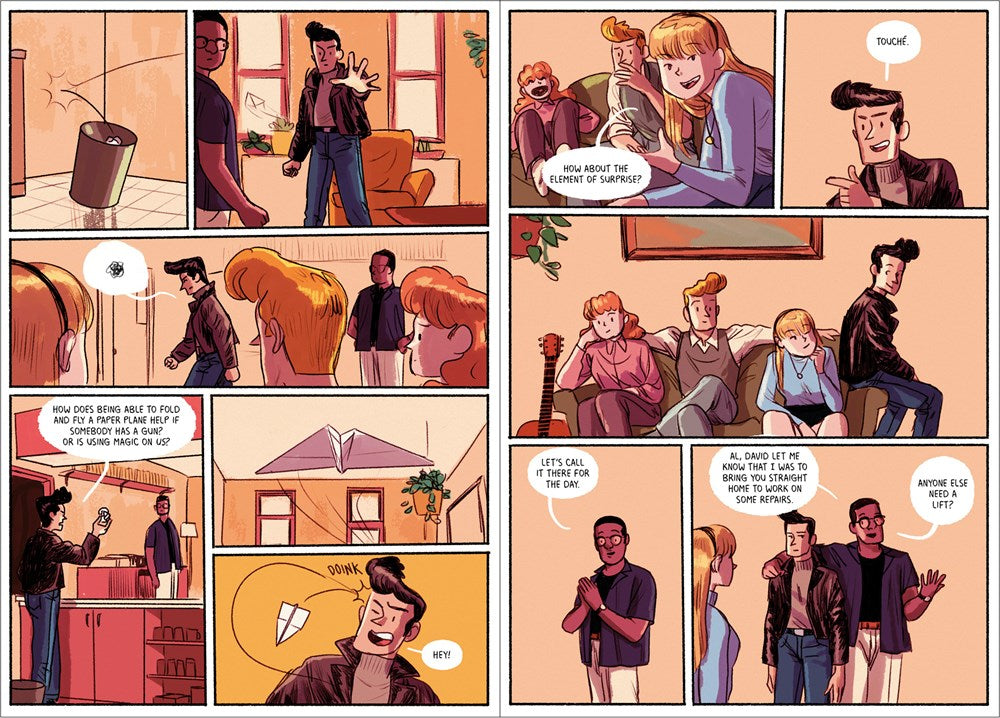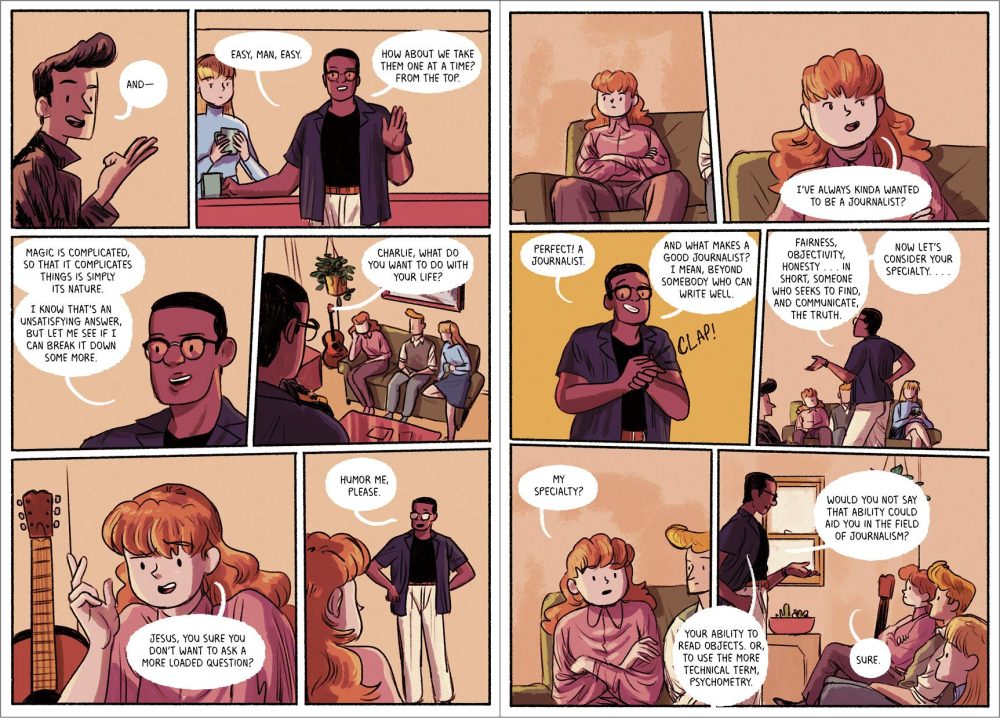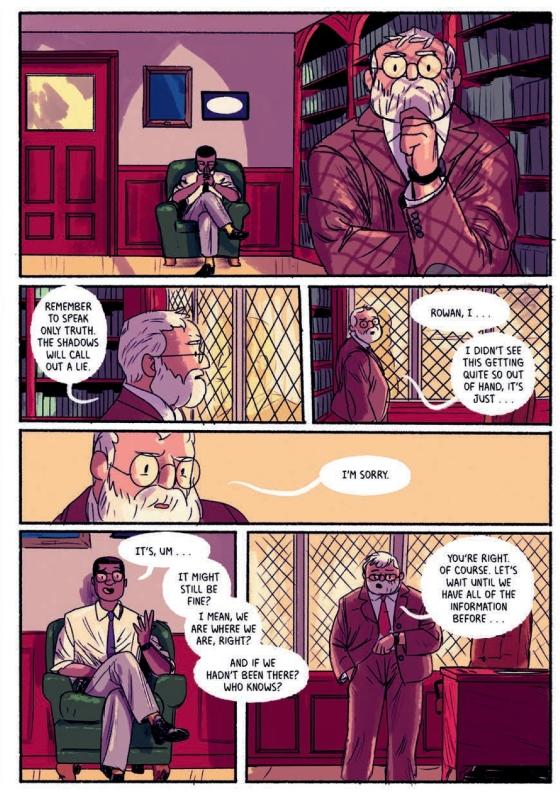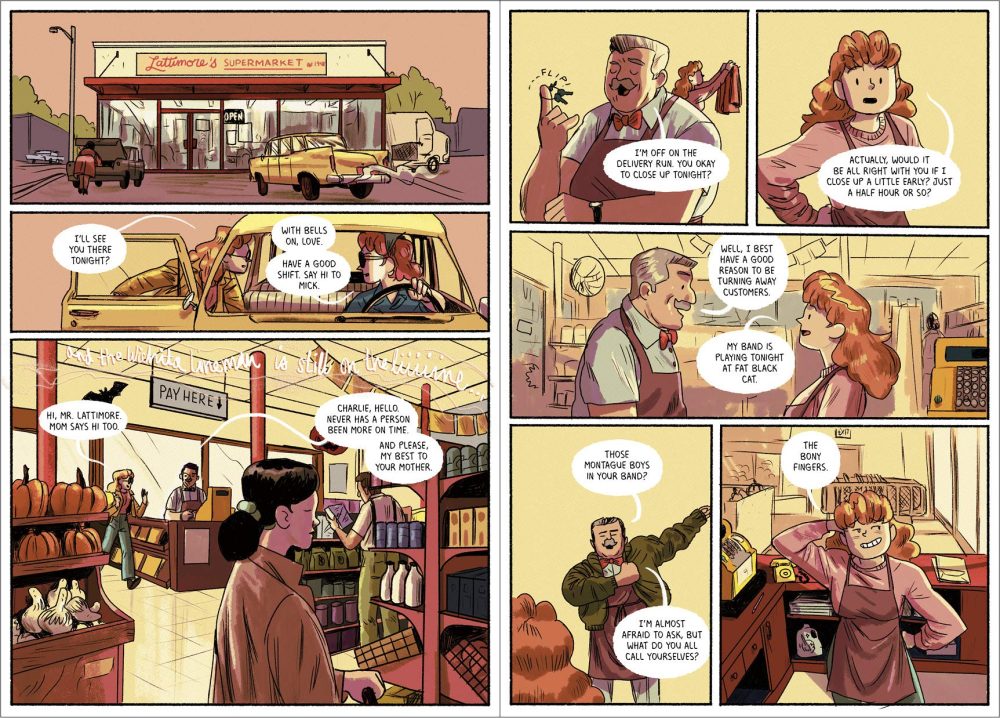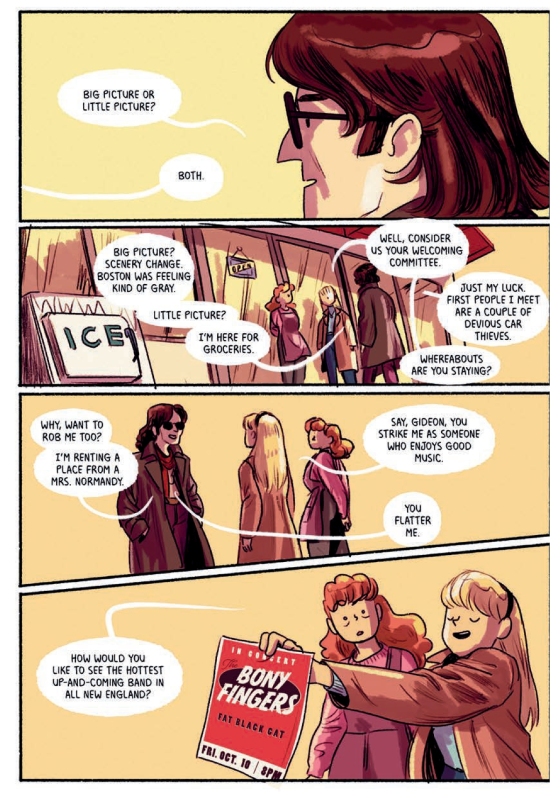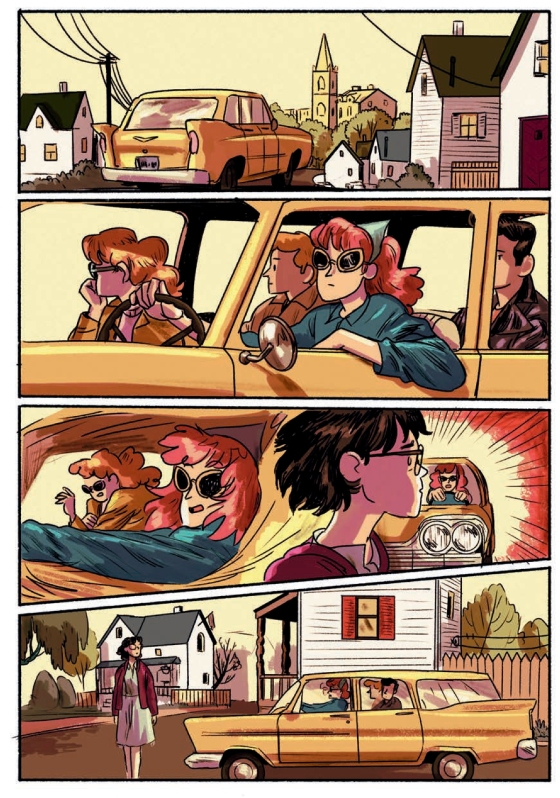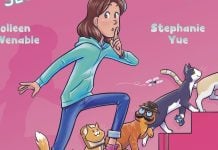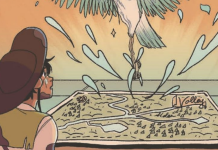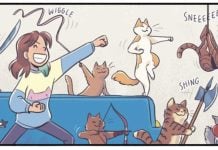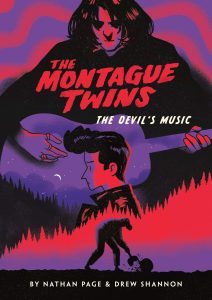
The Beat got the chance to catch up with Page and Shannon over Zoom to ask all about the musical influences behind the sequel, to discuss developing the magic of the series, and to find out what went into such an honest depiction of dealing with difficult mental health challenges.
AVERY KAPLAN: What was it like tackling the second volume of The Montague Twins? Did the experience differ significantly from the creation of the first volume?
NATHAN PAGE: It was pretty wildly different, in a lot of ways. We had so much time working on the first book, and just ideating. We spent years before we even put the comic on our website, conceptualizing the story. There was just so much. Really what the first book was more trying to fit in every one of our ideas, and just being like, “Oh, yes, we wanted this and we wanted this.” Whereas the second book was like, “We’re starting from scratch. This is all new. This is uncharted territory for us.”
It was a little daunting but in terms of the writing process, it actually came much quicker for me I think because I wasn’t trying to filter in five to six years worth of thoughts into it. When I was actually writing it, it came a lot quicker but it was pretty daunting.
DREW SHANNON: From my perspective, I switched over from mostly traditional linework to all-digital. At first, it took a little getting used to because I wanted it to still feel like the first book looked but also, I had a lot more control over it now. There was a bit of just trying to find that perfect balance between making it seem like it fits within the same narrative style that I’ve already started using and then also it being all digital now and I’m having a little bit more control over it. I think ultimately, I really like the way it turned out doing it digitally.
KAPLAN: I noticed the inclusion of several familiar songs in The Devil’s Music (with my personal favorite being The Archies). Can you tell us a little bit about the real-world musical influences on the graphic novel?
PAGE: Yes, absolutely. Of course, The Devil’s Music, it was a pretty big influence in multiple different ways. Not just in terms of what I was listening to but also with the subject matter as well speaking of a lot of my favorite artists and their struggles with depression, and addiction, and wanting to pay a certain amount of homage and love to them, like Nick Drake, absolutely. At the time around, outlining, I think one of my favorite artists the lyricist and singer, main songwriter from Frightened Rabbit was found after having killed himself. There was an element of wanting to bring that love into the book.
Then in terms of the actual songs that were picked, that process was a bit more fun and a bit more periods relevant. The Archies was one because I wanted to do a little link because sometimes people would say, “This book is a bit like Riverdale, it’s supernatural.” I’m like, “Oh.” It needs a little bit of a link to that. Then just some of my favorite songs and also really trying to express music like individuals expressing themselves through their musical tastes. Like through the one scene when Charlie goes to work and her boss is like, “Rock and roll isn’t my thing.” Then you have Glen Campbell’s Wichita Lineman playing, so also using it as a tool to express individualism within the story.
SHANNON: Music has always been a way for us I think in the story to also help solidify the time period. Even in the first book, we reference Woodstock and there’s some references to music in that as well that are important. Then I think also because Nathan and I, our friendship was born out of our love for music and bonding over similar artists and similar tastes so I think it was only natural that that was going to make its way into the text as well.
PAGE: Every piece, every page has a soundtrack. Every panel, there is always just a song to accompany it.
KAPLAN: Can you tell us about the artistic influences for The Montague Twins generally, and especially The Devil’s Music?
SHANNON: I love Tintin. I think it’s pretty obvious from the style that there’s a European French comics thing to it. I am also a big fan of a Canadian comic artist named Michel Rabagliati. He has a series of books about a character that’s pretty closely resembling himself called Paul. I feel like when I first started trying to tell my own stories, I took a lot of influence from that storytelling and that style too. I think even he himself is pretty much influenced by older vintage styles. I think for color and stuff, I don’t really have a point of reference other than films.
I just want it to look cinematic, I guess so I’m always trying to create evenly lit scenes as opposed to thinking of individual colors or that kind of thing. I just want it to feel like I’m creating a scene that has pretty consistent lighting. I look at film a lot for that because I feel like film uses color to establish mood and atmosphere and then it distinguishes that scene through scene. I feel like I get a lot of influence from that. Otherwise, I’m just looking at ’60s stuff trying to make sure that I’m also doing period stuff relevant or appropriately and making sure that everything fits the time period without being too over the top.
Arlo, the journalist’s apartment, there’s a shot of his apartment… I think I just like lifted that from Mad Men. Every time you Google 1960s apartment or something, it’s always this really mode looking or mid-century modern kind of thing that’s like only a designer would have made, but there isn’t just what people’s apartments would have looked like. I was like, “Well, Mad Men is good with that in terms of its set, production design,” and so I may have just… I think it’s Peggy’s apartment. I just took it. I was like, “I’m just going to draw it.”
KAPLAN: The Montague Twins has a fascinating and fresh magical world. What led into building out such a detailed backdrop?
PAGE: A lot of fun research like books, a lot of podcasts, and stuff. Really it came down to finding the right magical system that was not just like… I appreciate it in books when you can tell the author is obsessed over a magical system. From my perspective, it doesn’t feel human. It separates a magic user from just me. It always feels like a bit of a departure. What we were hoping to do, was make it a bit more universal and natural and try to make it a bit more organic in the world rather than in other things. While it is supernatural, we really wanted to try to find a way to make it naturally supernatural.
SHANNON: I think too the magic system, all the decisions we try to make are usually character-driven decisions, so it also needed to make sense with who the characters were and what we wanted to say with our characters. I think we tried to use it to help inform what decisions they’re going to make. I don’t really know exactly how to explain it other than that’s something we keep in mind, I guess. I feel like when we’re trying to come up with the magical stuff and the idea too that no one has all the answers. There is no system. There’s no book you can open and just reference any old spell, and then now you know how to do the spell. It’s not this thing that you can pin down quite so easily.
PAGE: It comes down to the individual.
KAPLAN: Speaking of backdrops, can you tell us about developing Port Howl? Was it difficult to create a fictional setting or did it come pretty quickly?
PAGE: I don’t think it’s necessarily difficult because even now, it’s still something we get to keep doing. If there’s something that we forgot, we can just pick up where we left off, like the grocery store, for example. There’s no reference to that in book one, but then I was like, “Well, of course, there’s a grocery store, and of course, it would have its owner.” Again, it just really comes down to, where are the characters going? Where do they need to be next? That’s what we’ll fashion in. Of course, that’s not to say we’re just making it all up on the spot. Port Howl has got a very rich history.
SHANNON: It also is really good at serving whatever plot we needed. I think that’s actually a cool thing about Port Howl is that it gets to be not like plot armor or anything but there is a way for it to exist more for our needs, as opposed to just existing on its own. Maybe that’s undoing a lot of what you just said. I’m thinking specifically of the library where the faculty headquarters is. It’s like, we get to just think of cool places, and why not? Why can’t it be in Port Howl, especially if it’s a mysterious kind of place. I think of the museum in the first book.
PAGE: It’s actually one of the best parts about it, and I hadn’t really thought about it until you asked it. It’s come so naturally. I will say from myself, I grew up in a place called Kingston, Ontario, which is surrounded by water on a lake, and very, very old and it’s haunted. I pulled a lot from Kingston. I haven’t been to New England.
SHANNON: Me neither. Neither of us have.
PAGE: So much of it has been pulling from, even just looking at a map, and then also like, “Oh, this place looks interesting.” Then going into a map from the ’60s, or different Google Images and being like, “This totally feels like it.” It’s been one of the most fun parts about writing the books, I would say.
KAPLAN: The Devil’s Music addresses mental health in an interesting and honest way. Was it important for you to include this element in the series?
PAGE: Yes, it was. I’ll be completely transparent. Depression, anxiety is something I’ve struggled with my whole life, continue to struggle with. At the time when conceptualizing the second book, I was not in a great place and I wanted to accurately reflect that feeling because I kept thinking about when I was the age of these kids, the things, the experiences that I was going through, and I was deeply depressed.
There are a lot of ways of trying to re-write this book where it doesn’t work but if it was going to, it needed to come from an honest place. I drew upon my experiences, even down my friends used to say when I would just disappear, “Where’s Nathan?” “Well, he’s gone to Narnia.” That was their way of understanding that I was still there, but I needed that space to try to come out of what I was going through at the time. That ties into the music aspect as well and the artists and the song. I knew it had to come from a truthful place or it wouldn’t work.
There’s a lot of pain, and there’s a lot of hope. At least I hope that comes through.
SHANNON: Something important to Nathan and I during the process was that it’s not the song that makes people depressed, or it makes people hurt themselves, that was not what it was. Rowan reiterates it later on in the book, but there’s a latency inside of people who are affected more deeply by it, of feelings that they are harboring. We wanted to make sure that there was a distinction between it being real and not, depression is not caused by magic because that’s not, for us, an accurate or honest depiction of what we thought we wanted to say.
PAGE: On the flip side of that, no magical solution. There could be no spell, potion, or anything that would take those feelings away. That would just be so false. That’s something that Drew was really good at keeping me honest about because sometimes while writing I’d be like, “Oh, maybe I can just do this.” He’d be like, “No magical solution, man, that is just not how that works.”
KAPLAN: Can you give us any hints about book three?
PAGE: Well, technically no. Only because we were not contracted for a third book presently. That said, we are working on the outline for another. To give anything away… I don’t want to make any assumptions. That would be a risky proposition. We were signed for a two-book deal. We delivered a two-book deal. The hope is that there will be plenty of more Montague Twins. I’m sorry that’s not a great answer.
SHANNON: The short answer is, we would love to tell you more but unfortunately, we cannot at this time.
PAGE: When we can, we will talk.
KAPLAN: Is there anything else that you’d like me to be sure and include?
PAGE: I think for myself it’s just hoping that people who read it feel seen and loved. Also, while it may reflect some painful feelings but also offer them a bit of an escape through those 300 and somewhat pages.
SHANNON: Well said. Not really sure I have anything else to add to that.
The Montague Twins: The Devil’s Music is available at a comic book shop and/or public library near you now. If you’ve had a chance to read The Devil’s Music, let The Beat know what you thought, either here in the comment section or over on social media @comicsbeat.


